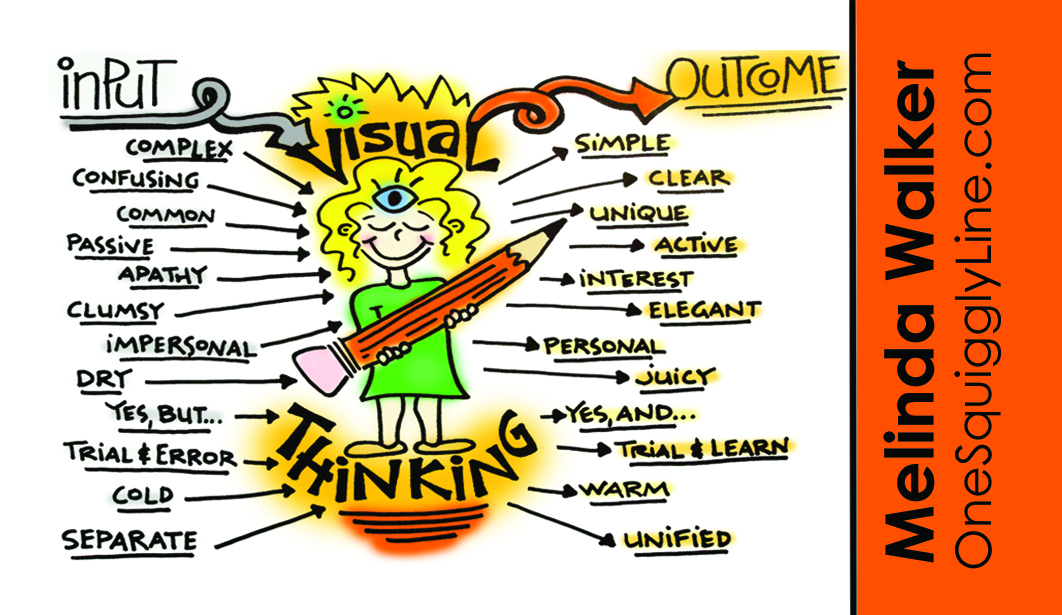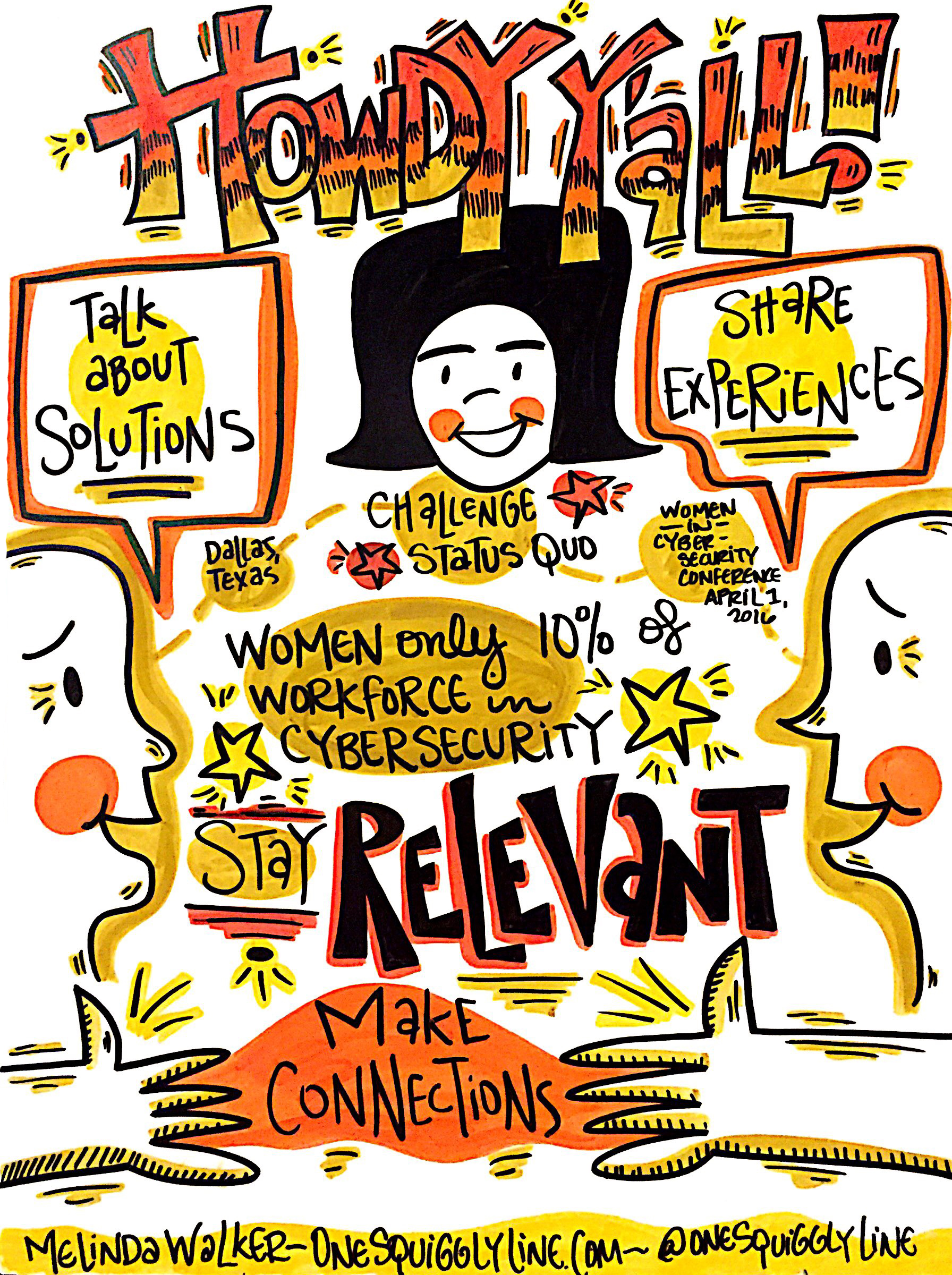What grabbed your attention first — the image above or the big chunk of text below?
Odds are, the image grabbed your eye first. It's probably the main reason you're reading the text in the first place! So go back to the image for a minute. Really look at it. READ it.
Now, read the paragraph below:
Visual thinking makes complex information simple, brings clarity to confusing communication, makes the common unique, turns the passive into the active and apathy into interest. With visual thinking, the clumsy becomes elegant, the impersonal becomes personal, the dry becomes juicy, "Yes, but..." is replaced with "Yes, and...", trial and error turns to trial and learn, the cold becomes warm, and the separate become unified.
That paragraph and the accompanying image say the same thing! Most people find the information easier to absorb through the image than the paragraph. They're able to absorb that information faster and remember it longer. And, it's a lot more fun!
Visual Notes: Sketchnotes
What exactly are sketchnotes?I define them as small-scale visual notes drawn in real-time, live or from audio or video files. Mine are usually in black-and-white. They can also be created from print materials, although those often end up being more like illustrations than sketchnotes. At least in my experience.
What's the difference between sketchnotes and illustration?The main difference between the two is the number of revisions — illustrations have many, sketchnotes have none!
The sketchnote above was drawn with an ultra fine Sharpie marker while listening to an audio file fromThe Business Soul Sessionsonline course by Beth Kempton. Sketchnotes from the course will continue to be added to thisFlickr albumandPinterest boarduntil the set is complete — close to 40 total!
Visual Thinking: Simple is Powerful
Friendly hand-drawn visuals can breathe new life into an old message. The topic of New Year's resolutions has been covered time and time again. So much so that people stop really paying attention to it. In effect, it becomes invisible.
When that happens, a new approach is needed. Something to break the pattern and grab people's eye. No need to make it fancy or complex. Simple can be very powerful. Plus, when you keep things simple, they're less scary so you're more likely to follow through.
Visual Thinking & Visual Notes: Live Graphic Recording
Hand-drawn visuals are far friendlier than standardized fonts and stock photos. And hand-drawn visuals are even more inviting when created live, right there where everyone can see.
The drawing above was created during the opening remarks at the Women in Cyber Security conference the end of March. It was then displayed near registration to welcome late-comers. Not a high resolution file shown here, just taken with my iPhone in the moment.
To see the whole set of visual notes from the Women in Cyber Security conference, check out this Flickr album.
Visual Thinking & Visual Notes: Live Graphic Recording
People often think I do a lot of drawing while taking live visual notes. If you really look at the image above, you'll see there's really not much drawing there at all. Just some squares, a couple of circles, and an arrow. That's it!
When you write words inside simple shapes, those simple shapes start making your own notes a bit more visual. They become more dynamic. More interesting. The image and the message become more unified. And far more powerful.
A great way to make your own notes more visual is to write some of your words inside simple shapes — circles, squares, triangles, arrows, etc. Give it a try!
The image above is a close-up of a 4'x8' drawing, created live, in real-time during a Design Thinking workshop. Be sure to check out the entire image!
Visual Thinking & Visual Notes: Live Graphic Recording at Events
There's never just one way to create visual notes, especially when they are created live. And at a large scale. That can make capturing a panel talk more of a challenge for some people. It takes a bit more flexibility than a clearly defined presentation.
I tend to capture panel discussions in a way that highlights the key points of the discussion as a whole. Not a series of summaries of what each person contributed. Since discussions tend to be rather fluid, the final visual makes much more sense that way. Speakers tend to like it better that way, too. So often key points build on what another speaker said, so there's no chance of misattribution when you capture the discussion as a whole.
The visual notes above were created during a panel discussion at TechInclusion last fall. You can see the whole set of visual notes created live, on-site there in this Flickr album.
Visual Thinking & Visual Notes: Sketchnotes
What exactly are sketchnotes? I define them as small-scale visual notes drawn in real-time, live or from audio or video files. Mine are usually in black-and-white. They can also be created from print materials, although those often end up being more like illustrations than sketchnotes. At least in my experience.
What's the difference between sketchnotes and illustration? The main difference between the two is the number of revisions — illustrations have many, sketchnotes have none!
The sketchnote above was drawn with an ultra fine Sharpie marker while listening to an audio file from The Business Soul Sessions online course by Beth Kempton. Sketchnotes from the course will continue to be added to this Flickr album and Pinterest board until the set is complete — close to 40 total!
Visual Thinking: Live, Large-Scale Visual Notes (Graphic Recording)
Awesome. Passion. Both very powerful, positive high-impact words. Notice the difference between reading those words in standard print here and seeing them used in a hand-drawn illustration above?
If you look closely at the above drawing with an analytical eye, you'll see there's really not much drawing there at all. Just a big orange heart and two smaller black ones. Plus a few lines here and there. That's it! Nothing fancy at all, yet much more powerful than those exact same words printed out in a computer-generated font. And even more powerful yet when you actually watch someone write them.
That's just a small sample of how powerful live, large-scale visual notes and graphic recording can be. Curious to learn more? Check out the One Squiggly Line's "Services" page for a lot of examples. Just imagine how much more powerful those images would be if you were right there, watching them being created live, right before your eyes!
Visual Notes: How to Choose Between Graphic Recording and Sketchnotes
Graphic recording. Sketchnotes. Visual notes. The terms are often used interchangeably. But there are some distinct differences. Graphic recording is usually done on flip chart or larger paper, foam core board, or white board, with the graphic recorder standing in front of the group. Sketchnotes are much smaller (think printer paper or a notebook) with the sketchnoter sitting down - mine are usually black and white, but they can also be in color, too. Visual notes is an umbrella term including both graphic recording and sketchnotes. At least that's how I define things.
If you're looking to hire someone to create visual notes for you, how do you know if sketchnotes or graphic recording is best for you?
Generally, if you're going to bring someone in to work in person with your group, graphic recording is the way to go. Part of what makes graphic recording so powerful is that everyone in the room can watch the image unfold along with the conversation. This continually draws people back into the content and keeps them engaged. When displayed after, the images allow people to literally see the big picture of the content and discuss it with those around them. This would happen on a much, much smaller scale with sketchnotes, simply because only a few people can look at them at the same time.
If you're looking for visual notes of a video or audio file, then sketchnotes would probably work best. Sketchnotes can be just as powerful as large graphic recording images when displayed online. If nobody will be around to watch the notes unfold and you're only interested in digital files, it really doesn't matter what size the original notes are.
The sketchnote above was created from an audio file for the online course The Business Soul Sessions.
Sketchnotes: Make online learning much richer!
Sketchnotes keep people engaged with your content in a whole new way. They can literally give students the big picture of each lesson or the course as a whole. Presenting information in new ways allows people to think about that information in new ways, too. And that's often when real learning takes place.
The sketchnote above was created from an audio file from one lesson of The Business Soul Sessions by Beth Kempton and Kelly Rae Roberts. They packed a lot of info into a very short talk! With the sketchnote displayed where students can look at it while listening to the file, students are much more likely to remember much more of what they just heard.









